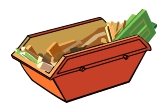
Managing, disposing of or recycling construction waste is a concern on any construction site – and is set to become much more important as the prices of building materials rise. Find out more about how waste is managed.

According to the ABS, construction and demolition waste may account for a staggering 40% of what ends up in landfills – with about 80% of that being bricks and concrete*.
Obviously there’s a lot of waste involved in housing construction, especially if an existing house is being demolished. While serious waste management plans are normally expected for big commercial and industrial project tenders, the same care’s not often put into waste disposal for residential building.
For now, it’s still relatively inexpensive and easy to dispose of general construction waste in landfills, although this is likely to change pretty dramatically in the near future. Increasing production costs and regulations that require lifecycle assessments or other energy efficiency measures for building materials, methods and designs are likely to make residential construction waste a serious consideration – eventually.
Recycling construction waste
Some builders – particularly those with a focus on sustainability and efficiency – work to ensure that materials are recycled and reused. This may include training subcontractors to categorise and separate waste on-site before it’s disposed of, to ensure that it goes to the right places.
Demolishers in particular often do a good trade in reselling things like picture rails, skirting boards, floor boards, doors, ornate windows and frames, light fittings and so forth, and will often deconstruct or dismantle to some extent rather than simply demolishing a home.
Minimising waste on construction sites
Builders can also employ various measures to minimise the amount of waste that’s produced in the first place. Their suppliers have a role to play in this too, either by supplying at the last minute (i.e. ‘just in time deliveries’) to help reduce the amount of packaging that’s needed and the chance of breakage or spoiling, or by agreeing to take back the materials that are left over.
Builders can also train their subcontractors to use offcuts in other parts of the house to help cut down on waste too.
One of the biggest arguments made for prefabricated housing is that there’s less waste produced in the first place with this kind of construction.
Skips and waste removal
Building sites will usually feature massive bins (called skips) that are dropped off at the site and used to collect and remove waste as it’s generated. Rubbish skips are normally stored either on the building site, or just off the site in a position that won’t cause a problem to traffic or pedestrians.
Regional limitations
For the time being the cheapest and least complicated option is normally just to fill a skip and throw everything into a landfill. Having said that, a builder’s ability to do much else with the waste will also depend on whether recycling facilities are actually available where the house is being built, and how willing suppliers are to help reduce waste in the first place.
For more information, ask your builder how waste minimisation and disposal will work on your site.
*Source: ABS – The WasteWise Construction Program.





